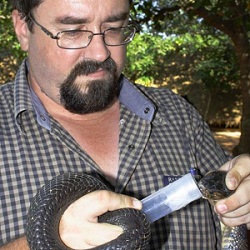Snakebites? Like having my hand smashed by a hammer’

“The first time was pretty terrifying because I didn’t know what to expect. It felt like having my hand smashed with a hammer,” he says.”My last snakebite would have been a fatal one, but for the fact we were carrying an emergency medical kit so we could do something about it.”
Dr Williams, an expert on snakebites at the World Health Organization (WHO) – who travels the world collecting snake venoms to help develop new treatments – says most victims “don’t have that life-saving luxury”.The WHO calls snakebites “arguably the world’s biggest hidden health crisis”, with one person dying from a bite every four minutes. Hundreds of thousands of others are left seriously disfigured, with many needing amputations.
Dr David Williams has been bitten by a snake six times.Snakebites mainly affect people living in some of the poorest communities in the poorest parts of Africa, Asia and Latin America. Farmers risk their lives and livelihoods every day while simply tending to their crops, where deadly snakes lurk. Children often become victims too.So now two major health organisations – the WHO and the UK’s Wellcome Trust – are taking steps to tackle snakebites.
The Wellcome Trust is investing £80m into a new programme to invest in new treatments and better access to effective anti-venoms.And the WHO is preparing to publish a plan to halve the number of deaths and disabilities caused by snakebites by 2030.”We’re at a very important point in the effort to do something about snakebite for some of the poorest people in the world,” says Dr Williams.
“Many already live in poverty and the consequence of snakebite is that they are driven further into debt and despair, even if they survive.”There are around 2.7 million cases of snake “envenoming” (poisoning from venom getting into the blood via a bite or being sprayed into the eyes) every year
Between 81,000 and 138,000 people die annually
Around 400,000 people will suffer permanent disability
Venomous bites can cause paralysis, kidney or liver failure, fatal bleeding or amputation
Source: World Health Organization
Snakebite, though potentially lethal, is treatable. Wellcome’s director of science, Prof Mike Turner, says: “With access to the right anti-venom there is a high chance of survival.”While people will always be bitten by venomous snakes, there is no reason so many should die.”
Dr Philip Price, science lead for snakebites at the Wellcome Trust, says there is a “spiral of decline” when it comes to dealing with snakebites.”The treatments are expensive, the people who need them often can’t afford them, and in some cases people can’t make it to the hospital in time.”
Dr Price said that even when people do reach hospital, sometimes the doctors are not trained adequately, and often treatments are not available.He said patients may instead turn to traditional healers, meaning they “fly under the radar” so “most countries aren’t even aware they have a snakebite problem”.
Anti-venom treatment is made in the same way that it has been for more than 100 years. The costly and laborious process sees antibodies harvested from horse blood to make anti-venom.But even so, it is estimated that the world produces only a third of the anti-venom that it needs.
The horses are given very low doses of snake venom over long periods of time, so it does not harm the animal, says Dr Price.”Eventually the blood is taken from the horse, and the antibodies are purified out. The antibodies inside that blood then bind and neutralise the venom.”It’s not without risk to inject this directly into the patient.”These risks mean victims have to be treated in hospitals, which can take hours or even days for people to travel to. That is often too late to save lives and limbs.
Another major challenge is that many of the anti-venoms available are not actually effective. Different types of snakebites need different types of anti-venom.
In Africa, for example, up to 90% of available anti-venom is thought to be ineffective.There is currently no authoritative international list that exists of all the anti-venoms available and what they actually treat.
Despite the challenges, achieving the WHO goal of halving deaths and disabilities from snakebites over the next decade is “not all that difficult”, according to Dr Williams.
“In 2003 in Papua New Guinea, one in every four children who were bitten by snakes died. Today it’s less than one in every 50.”Dr Williams says whilst this is still too many deaths, the solution is “not rocket science”.
“It’s about having safe, effective anti-venoms, trained health workers, communities that are engaged in the problem and are taught how better to prevent snakebite, and what to do when someone is bitten.”He said a desperately needed spotlight is finally being placed on this avoidable killer.
The WHO will announce its strategy to cut snakebite deaths and disabilities later this month at the annual World Health Assembly in Geneva.





